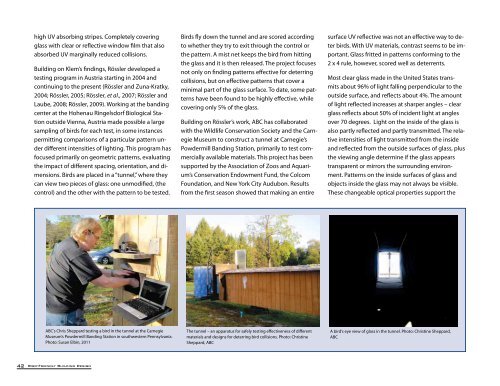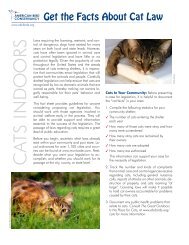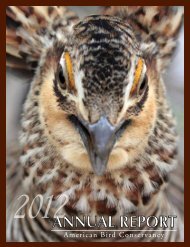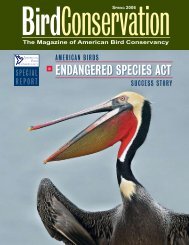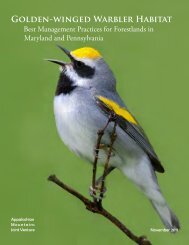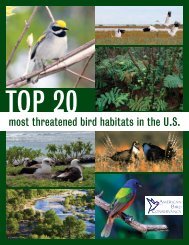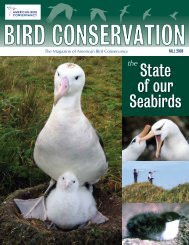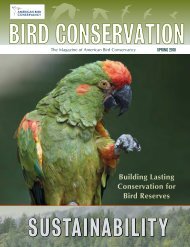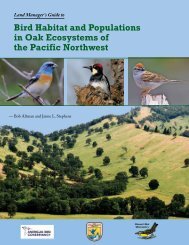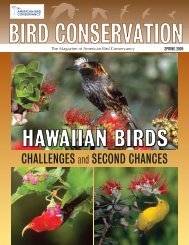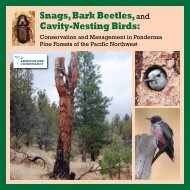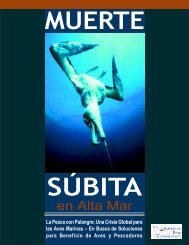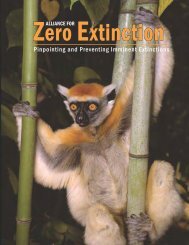Bird-Friendly Building Design Bird-Friendly Building Design
Bird-Friendly Building Design Bird-Friendly Building Design
Bird-Friendly Building Design Bird-Friendly Building Design
Create successful ePaper yourself
Turn your PDF publications into a flip-book with our unique Google optimized e-Paper software.
high UV absorbing stripes. Completely coveringglass with clear or reflective window film that alsoabsorbed UV marginally reduced collisions.<strong>Building</strong> on Klem’s findings, Rössler developed atesting program in Austria starting in 2004 andcontinuing to the present (Rössler and Zuna-Kratky,2004; Rössler, 2005; Rössler, et al., 2007; Rössler andLaube, 2008; Rössler, 2009). Working at the bandingcenter at the Hohenau Ringelsdorf Biological Stationoutside Vienna, Austria made possible a largesampling of birds for each test, in some instancespermitting comparisons of a particular pattern underdifferent intensities of lighting. This program hasfocused primarily on geometric patterns, evaluatingthe impact of different spacing, orientation, and dimensions.<strong>Bird</strong>s are placed in a “tunnel,” where theycan view two pieces of glass: one unmodified, (thecontrol) and the other with the pattern to be tested.<strong>Bird</strong>s fly down the tunnel and are scored accordingto whether they try to exit through the control orthe pattern. A mist net keeps the bird from hittingthe glass and it is then released. The project focusesnot only on finding patterns effective for deterringcollisions, but on effective patterns that cover aminimal part of the glass surface. To date, some patternshave been found to be highly effective, whilecovering only 5% of the glass.<strong>Building</strong> on Rössler’s work, ABC has collaboratedwith the Wildlife Conservation Society and the CarnegieMuseum to construct a tunnel at Carnegie’sPowdermill Banding Station, primarily to test commerciallyavailable materials. This project has beensupported by the Association of Zoos and Aquarium’sConservation Endowment Fund, the ColcomFoundation, and New York City Audubon. Resultsfrom the first season showed that making an entiresurface UV reflective was not an effective way to deterbirds. With UV materials, contrast seems to be important.Glass fritted in patterns conforming to the2 x 4 rule, however, scored well as deterrents.Most clear glass made in the United States transmitsabout 96% of light falling perpendicular to theoutside surface, and reflects about 4%. The amountof light reflected increases at sharper angles – clearglass reflects about 50% of incident light at anglesover 70 degrees. Light on the inside of the glass isalso partly reflected and partly transmitted. The relativeintensities of light transmitted from the insideand reflected from the outside surfaces of glass, plusthe viewing angle determine if the glass appearstransparent or mirrors the surrounding environment.Patterns on the inside surfaces of glass andobjects inside the glass may not always be visible.These changeable optical properties support theABC’s Chris Sheppard testing a bird in the tunnel at the CarnegieMuseum’s Powdermill Banding Station in southwestern Pennsylvania.Photo: Susan Elbin, 2011The tunnel – an apparatus for safely testing effectiveness of differentmaterials and designs for deterring bird collisions. Photo: ChristineSheppard, ABCA bird’s eye view of glass in the tunnel. Photo: Christine Sheppard,ABC42 <strong>Bird</strong>-<strong>Friendly</strong> <strong>Building</strong> <strong>Design</strong>


